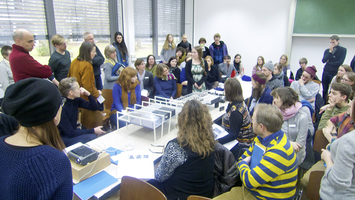The professorship particularly focuses on the work of Lucius Burckhardt (1925-2003), who, together with Annemarie Burckhardt (1930-2012), conducted research and taught at the University of Kassel in the specialist department of architecture, urban planning and landscape planning from 1972 until 1997. Lucius Burckhardt had been grappling with questions of design in our environment very extensively since the early 1950s and moved about freely between the disciplines of architecture, urban planning, landscape planning, design, sociology, economics or art history. His themes were, on the one hand, the preconditions for architecture, design and style and, on the other hand, their consequences for society. He summarised his observations and findings in the following questions and formulas: “Who plans the planning work?” “Why are landscapes beautiful?” “Design is invisible” “Destroyed by upkeep” or “The tiniest intervention” and invented a name for his speciality in the 1980s: walking science, promenadology or strollology. Annemarie and Lucius opened up new vistas for many students – not only in the design subjects. They left their mark in Kassel with numerous projects – e.g. the “documenta urbana – sichtbarmachen” in 1982 or “The journey to Tahiti” in 1987 at the Dönche Nature Reserve in Kassel. Lucius Burckhardt said, “You can probably only communicate particular points of view through art, as restricted sight is so prevalent nowadays that people hardly have the distance any longer to offset this. Only art can communicate this without being moralising or harmful.”
The course in this field communicates the diverse and complex themes in the life’s work of Lucius and Annemarie Burckhardt, asks for meaning for design in our present age and aims to continue developing the thoughts of the two people in seminars and projects. A Lucius Burckhardt Convention is also held at irregular intervals, where whole-day international symposiums with lectures by guests, who learned from the Burckhardts, spend considerable time focusing on their life and work or whose work is close to the Burckhardts’ in terms of its ideas and makes a contribution to further developing them; the 1st Lucius Burckhardt Convention was held on 17 May 2014 and the 2nd Lucius Burckhardt Convention on 17 June 2017 at the Kunsthochschule Kassel. More information is available at: www.lucius-burckhardt.org
Lucius & Annemarie Burckhardt Professorship
mehr…

Regardless of the relationship that designers have with trams, now or in the future, they should know this: what are the benefits of the most beautiful design for a tram if it does not operate at night? The project focused on how things might deteriorate if a so-called network reform – like the one planned by the Kassel Transport Authority – is introduced. Interviews were conducted with passengers and the history of the relationship between individual and public transport was discussed.

A “documenta urbana – sichtbarmachen” exhibition was held in Kassel in the summer of 1982. What was it? Ideas were gathered by international participants – including so-called lay persons – for 15 locations in the inner city of Kassel on how each place could develop or what was missing there. How could this idea be communicated or be made visible to the public 33 years later to mark the jubilee? The project involved a design for this communications process, ranging from the design intervention in the outdoor space to the production/design of other helpful media alongside the Rundgang (guided tour) in July 2015.

New books about design. Which books about design were published in 2015? The seminar during the 2015/16 winter semester started with an excursion to the Book Fair in Frankfurt. All the participants made personal contact with publishing houses, selected new publications in line with their personal interests and special focus, presented the books in the seminar and wrote a review.

The changes during the last 25 years related to the medium of books, ranging from desktop publishing to Amazon, also affect libraries. Has their role changed? What should the library at our college of fine arts look like in future? The spectrum within this project (2014/15 winter semester) ranged from media theory to specific designs and they have been incorporated in the current library planning work. The photo shows the presentation of the designs.